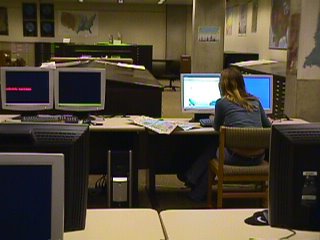 Geospatial Center & Map Collection GIS Workshop and Assistance Connects Researchers to Data for Project
Geospatial Center & Map Collection GIS Workshop and Assistance Connects Researchers to Data for ProjectUniversity Libraries' Library Insider article by Angela Gibson, GIS Specialist
Two Ball State researchers are using services from the Libraries’ Geospatial Center and Map Collection (GCMC) to collaborate geographic datasets for their research project to learn more about the living and working experiences of former patients at Central State Hospital.
David Perkins, Ph.D., Department of Psychological Science, and Josh Raines, a graduate assistant in the Social Science Research Center, will use the versatile and powerful tools available by geographic information systems (GIS) to obtain special data which will help them research community conditions faced by former hospital inpatients.
More than 100 former patients are living at various locations in Marion County since the closure of the Indianapolis hospital. The researchers hypothesize that those individuals should live in neighborhoods distributed at random among the residential districts of a city rather than being clustered or
dispersed.
“The benefit of using GIS in this project is the way it adds systematic spatial and geographic details to the description and understanding of former inpatients' experiences of living in the community,” said Josh. “We were pleased that everything we needed seemed to be available at Ball State, including technical assistance from the University Libraries.”
Dr. Perkins learned about the SAVI website and its capabilities during a workshop called, “GIS Data: Finding Reliable GIS Data on the Web,” which was held by Angie Gibson, GIS Specialist in the University Library’s Geospatial Center and Map Collection. After the researchers attended the GIS workshop, they contacted Angie at various times for assistanceduring the research project.
The two researchers geocoded a list of former patients’ addresses, along with United States census indicators and information from the Social Assets and Vulnerabilities Indicators, www.savi.org. Angie helped them during the geocoding process and showed them how to join the geocoded address points to the census tract layer to establish census tract numbers for all the address points.
Geocoding is a GIS operation for converting street addresses into spatial data that can be displayed as features on a map, usually by referencing address information from a street segment data layer.
Other spatial variables, such as crime rates, accessibility of parks, libraries and other community resources, can be added to the database. This geographic information will be combined with other data on the persons in recovery, including psychiatric services they were receiving, whether they were working, and ratings of recovery made by their primary therapists and will examine how the particular census tracts compare with Marion County as a whole in terms of social disorganization, transience, and the percentage of persons having disabilities.

No comments:
Post a Comment